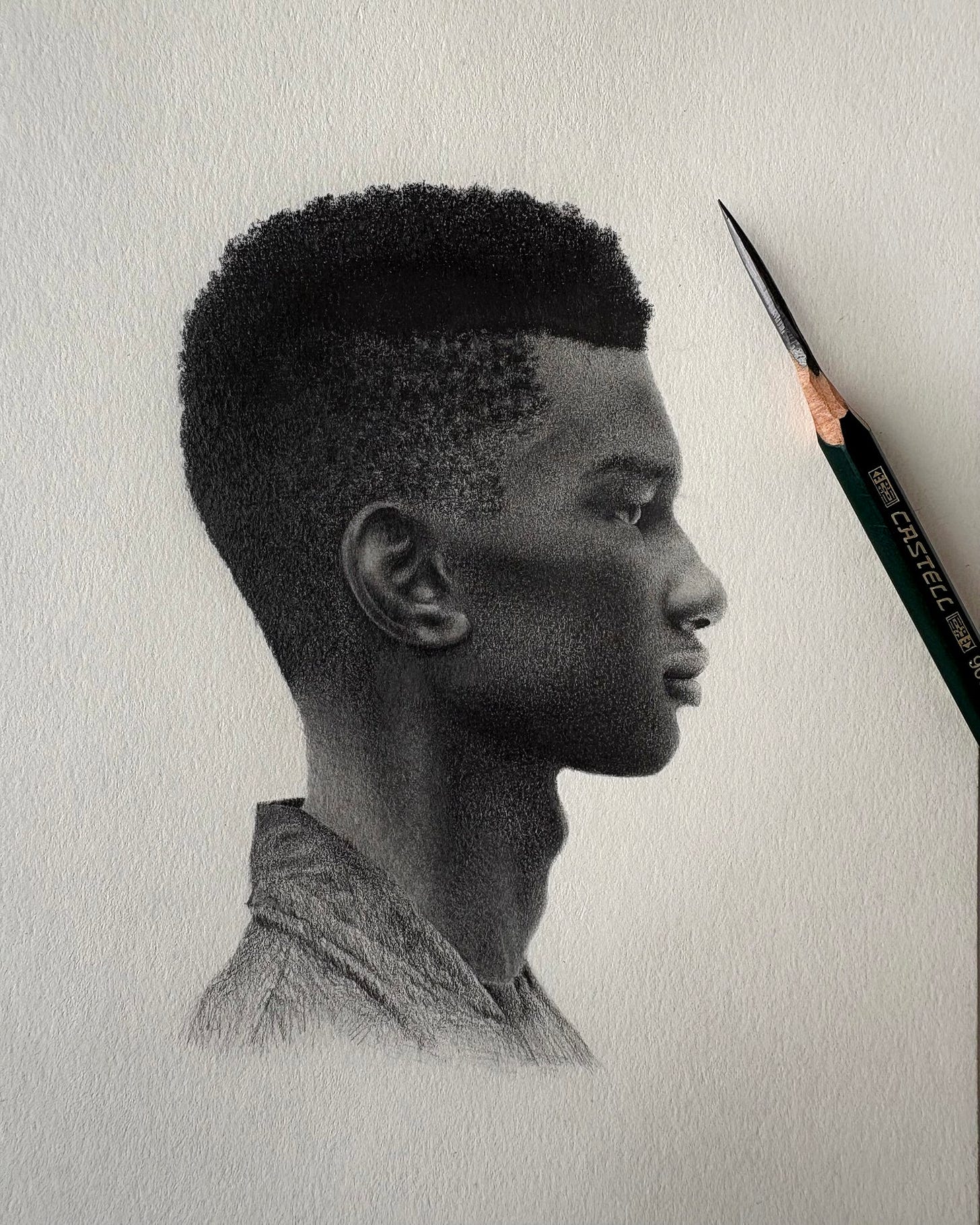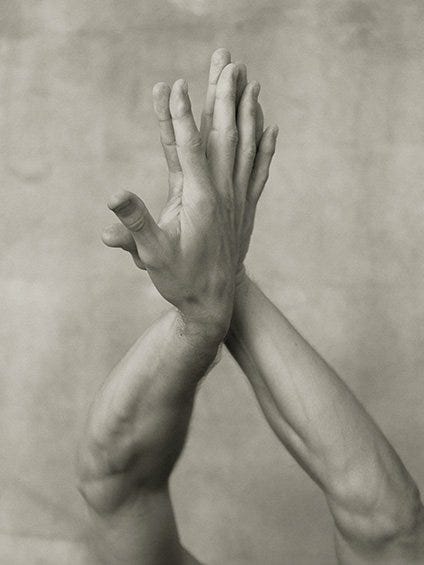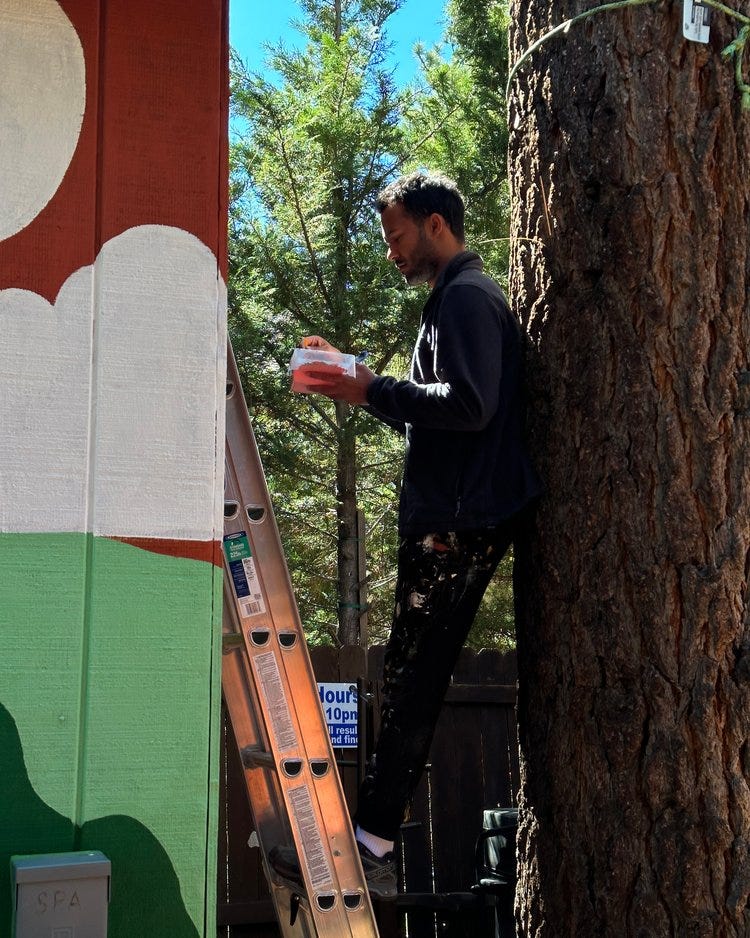This is my first interview with a career artist, and I couldn’t have picked a more fascinating subject—Parker Thornton, an artist, photographer, and adventurer whose work blends beauty with technical mastery.
I first discovered Parker during my routine Substack deep dive, where I hunt for inspiring artists, writers, and designers. His work immediately stood out—not just for its striking visuals but for the way he effortlessly captures movement, light, and emotion.
As I dug deeper, I realized his artistic journey was more than just visually compelling; it was sustainable. Parker is a full-time artist, his Substack Wandering draws a devoted audience, and his illustrated notes spark hundreds of comments and likes. From the outside, it all looks effortless. But behind it lies years of exploration, discipline, and creative risk-taking.
Here’s how Parker describes Wandering:
"Wandering is a newsletter/blog designed to inspire, connect, and spark your adventurous spirit by sharing an inside look into my life as a creative nomad.”

Parker is very devoted to all aspects of being an artist, including finding his voice and style and the people who support his artistic journey. He has combined his artistic excellence with his penchant for advocating for his work, which has led to a thriving art career.
Path to Becoming An Artist.
For Parker, art isn’t just a passion—it’s an inseparable part of who he is. He says he’s been making art for as long as he can remember, but the real shift happened in his early teens, thanks to the mentorship of his high school art teacher, Mrs Marnie Hart. She didn’t just teach technique; she introduced him to foundational practices that still shape his work today, including meditation as a tool for creativity.
Despite his love for art, Parker initially took a different path. He earned a full soccer scholarship to a D1 college, Northern Illinois University for Business Management, but the pull of art was stronger. His entire tuition fee was paid for, including his room and board. Dropping out to pursue art full-time was a bold move—one that speaks to his deep sense of purpose at a young age. This decision required immense confidence and clarity about his artistic calling, as he was willing to walk away from a secure path to follow his true passion.
Returning home, Parker threw himself into photography while working part-time jobs to stay afloat. Those years were a mix of exploration and survival, as he tried to piece together what a sustainable creative career could look like.
Then, a defining moment: Parker lost his job. But just one day later, he landed the biggest photography gig of his career. It felt like a sign. Instead of searching for another job, he made a decision—he was going all in.

Building A Foundation
Parker’s first big break came with Vice Magazine, but even then, he never saw himself as just a photographer—he saw himself as an artist. For him, photography wasn’t just about capturing images; it was about crafting a unique voice and style. He spent years shooting everything—people, animals, plants—searching for what truly resonated with him. It took him three to four years to build that foundation, a period of relentless exploration before he could expand his work and connect with the right people.
“I want to find something I can call my own, in a style that people could see and associate with me. So in those first four years when I was working those part time jobs, that's what I was doing..”
Parker firmly believes that artists must dedicate significant time to discovering their voice and mastering fundamental skills before building upon them. Without a strong foundation, gaps will continually emerge, requiring constant effort. To create sustainable work, artists must define their identity and clarify their message to the world.
I love this quote from him and find it very inspiring.
“…if you want to have longevity, I think it's important to know who you are through your work. Know what you want to say.”
Though he never attended a formal art school, Parker credits his high school art teacher, his mother, and his grandmother, who were also artists, for shaping his artistic foundation. He found inspiration in the minimal, intentional designs of 1930s Japan and spent years sketching, refining, and searching for a style that felt distinctly his. But at the core of his work, one theme remained constant: a deep fascination with mysticism and the mysteries of the natural world.
Art as a Service
What stood out to me about Parker was his optimism and his belief that the world needs art. He doesn’t see being an artist as just an inward-looking exercise; he sees it as an act of service. Here is his quote (edited for clarity)
“..sometimes it feels like we're just making stuff, just making beautiful stuff, and putting it out into the world. Sometimes it can make artists feel as though they're not giving or serving at a larger level, like being in the medical field or being a police officer, where you're literally helping to do something as a servant. But I think artists are just as important, in every way, our whole world is shaped by creative minds.
This statement reflects Parker’s clarity and confidence—not just in his own work, but in the role of artists in society.
Finding Your People
After laying a strong foundation, Parker believes the next crucial step for artists is getting their work out into the world and truly understanding their audience. Art isn’t for everyone—so finding the right people is essential.
“Get clear on two things, what you want to say with your work, who you are, and understanding who you're trying to speak to through your work.”
For Parker, building an online presence was vital as a visual artist, but equally important was showing up in his community—making connections, getting his name out there, and ensuring people knew his work existed. The more consistently he did both, the more opportunities came his way.
There’s no single, linear path to finding your audience. But Parker emphasizes one thing: consistency. Whether through social media, community engagement, or direct outreach, consistently putting work in front of the right people has been key to his success.
His audience has found him through local shops, galleries, social media, and most notably, Substack, which has been a promising platform for him. Instagram has also been valuable, but Parker stresses that engagement matters more than just posting. Seeking out aligned people, companies, shops, and galleries—and actively putting his work in front of them—has made a real difference.
As someone who travels often, Parker makes a point to visit art shops, galleries, and events in towns where he feels his work would resonate. He strikes up conversations, hands out postcards, and fosters real-world connections. But if he had to choose one tool for artistic growth, both creatively and financially, it would be his newsletter.
“I'd say that if you could choose one tool to show up, to help you really expand and grow as an artist, financially in every way, having a strong newsletter is number one. That is the best one.”
Mental Toughness
Parker and I talked about resilience, grit, and the relentlessness required to sustain a creative career. He shared a period when his photography work had slowed dramatically, and despite pouring energy into his art business, it had yet to take off. Financial stress mounted, and self-doubt crept in.
Then, just days after hitting a low point, he reframed his perspective. He realized that setbacks weren’t signs to quit—they were simply part of the journey.
“it does take a lot of resilience. It takes a lot of discipline and a lot of just overwhelming belief in yourself. You know, as corny as it might may sound, you have to really have a strong belief that this is your purpose, and it doesn't matter if you're, you know, pulling in all the money, or if things get slow, you just stay stay focused and not waver.”
Parker believes that what separates highly successful artists from the rest is their ability to persist through uncertainty. The creative path is rarely linear. Some days, momentum builds effortlessly; other days, it stalls completely. Accepting this ambiguity—rather than fighting it—is key to longevity in the arts.
Leaning into discomfort is essential, especially for artists who come from structured environments like school or traditional jobs. There’s no syllabus, no clear promotion path, no guarantees. The challenge is not letting the unpredictability paralyze you but instead showing up consistently, building momentum, and trusting that things will take shape over time.
We also discussed how life circumstances—starting a family, buying a house, or other major transitions—can alter artistic ambitions. Parker had an interesting perspective on this: he believes it’s okay to pause an artistic career if necessary, as long as the artist knows, deep down, that they will return.
This resonated with me personally. Having children changed my ability to show up as an artist every day. I struggled with ambiguity and the lack of financial stability, so I pivoted, developing other skills in design and research. But now, I feel ready to return to making art—this time with a stronger foundation.
Parker sees himself as an artist first and an entrepreneur second. He acknowledges that treating art as a career means embracing both creative and business mindsets.
“You have to be you have to take notes from the entrepreneurs, and you have to take notes from the artists and put it all together.”
This sentiment reassures me. A decade ago, I didn’t fully grasp the business side of making public art—considerations like liability, engineering, maintenance, and pricing. But now, I have a deeper understanding of the people buying my work, and I can charge accordingly. My children are growing more independent, and I feel ready to dive back into making large-scale art while staying mindful of the business side.
To Sum Up
Parker Thornton’s journey is a testament to the dedication, resilience, and strategic thinking required to sustain a creative career. His insights offer valuable takeaways for artists navigating their own paths:
Build a Strong Foundation – Spend time mastering your craft and developing a unique artistic voice before trying to scale your career. Without this, gaps will always appear later.
Art is a Service – Believe in the value of your work. Art shapes emotions, perspectives, and culture, making it just as important as other service-based professions.
Know What You Stand For – Define what you want to say with your work. Clarity in your message and identity will make your art more recognizable and impactful.
Find Your People – Your art isn’t for everyone, and that’s okay. Focus on connecting with the right audience—whether online, in galleries, or through direct outreach in communities that align with your work.
Show Up Consistently – Growing as an artist requires creative output and visibility. Post your work, engage with others, and make your presence known in real-world spaces like galleries and shops.
Resilience is Key – There will be slow periods, self-doubt, and financial struggles. Staying committed through tough times is what separates successful artists from those who give up.
Treat Art Like a Business – If you want to make a living from your art, approach it with an entrepreneurial mindset. Build relationships, market your work strategically, and use tools like newsletters to grow your audience.
Leverage Multiple Platforms – Don’t rely on one channel. Use social media, newsletters, galleries, and real-world networking to create opportunities for your work to be seen and sold.
Engagement Matters More Than Just Posting – It’s not enough to put your work out there; interact with your audience, reach out to aligned brands and galleries, and build meaningful connections.
Lean Into the Uncertainty – The artist’s path isn’t linear. Instead of fearing unpredictability, embrace it as part of the journey. Keep creating, keep adapting, and trust that consistency will build momentum over time.
What stood out most to me about Parker was that he doesn’t just create—he intentionally builds a sustainable artistic life through discipline, strategy, and deep conviction. His journey is a reminder that talent alone isn’t enough; it’s the relentless pursuit of honing your voice, making intentional choices, and shaping a life where art can thrive. Building an artist’s life isn’t just about making work—it’s about creating the conditions that allow you to keep making it. That’s why I’d pay close attention to any advice he gives.
You can subscribe to Parker’s Substack here.






A really interesting read, thank you Shagun. I’ve just subscribed!
Nicely done! I was fully engaged. I understand the points being made from the artist's perspective. You summed it up well.